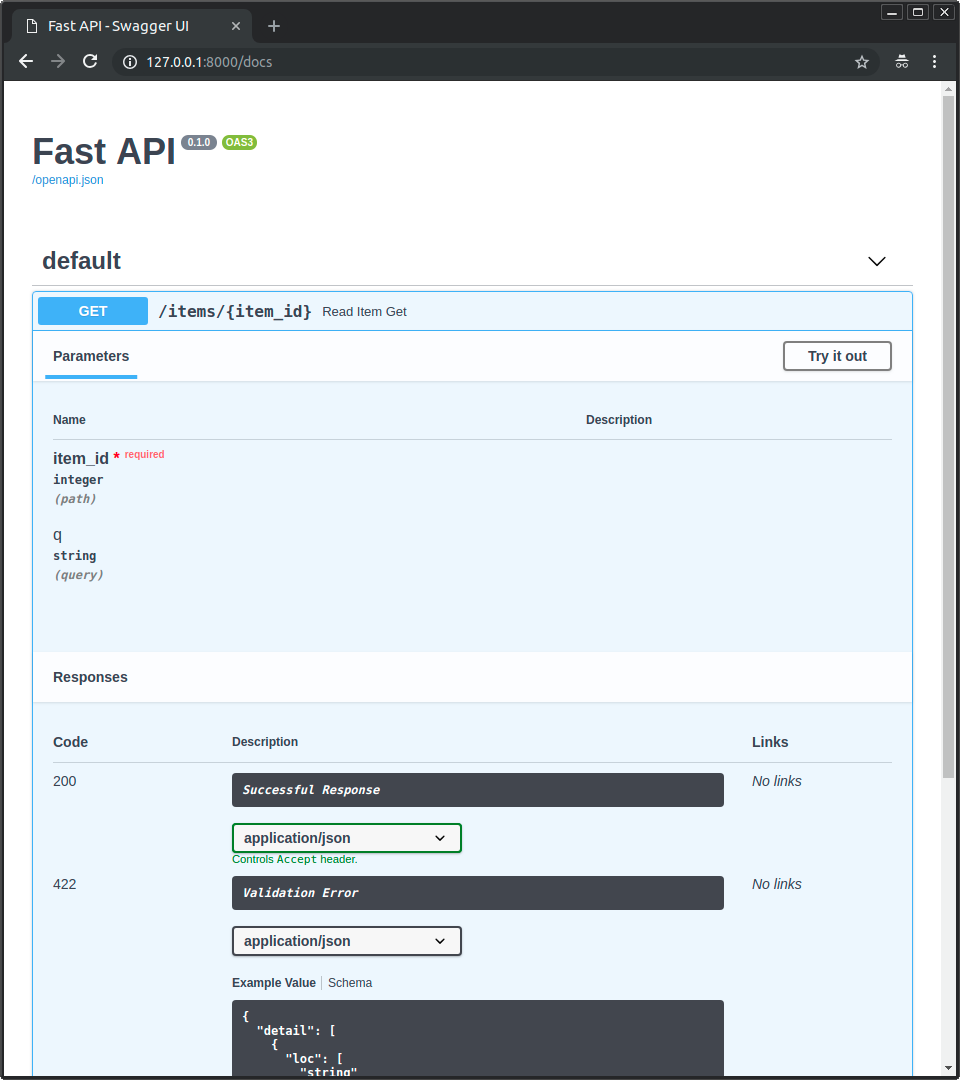- Sort Score
- Result 10 results
- Languages All
Results 1 - 10 of 94 for Sample (0.17 sec)
-
docs/en/docs/tutorial/testing.md
```Python hl_lines="3" {!../../../docs_src/app_testing/test_main.py!} ``` ...and have the code for the tests just like before. ## Testing: extended example Now let's extend this example and add more details to see how to test different parts. ### Extended **FastAPI** app file Let's continue with the same file structure as before: ``` . ├── app │ ├── __init__.pyPlain Text - Registered: Sun May 05 07:19:11 GMT 2024 - Last Modified: Thu Apr 18 19:53:19 GMT 2024 - 6.2K bytes - Viewed (0) -
docs/em/docs/tutorial/first-steps.md
 ### 🎛 🛠️ 🩺 & 🔜, 🚶 <a href="http://127.0.0.1:8000/redoc" class="external-link" target="_blank">http://127.0.0.1:8000/redoc</a>. 👆 🔜 👀 🎛 🏧 🧾 (🚚 <a href="https://github.com/Rebilly/ReDoc" class="external-link" target="_blank">📄</a>):  ### 🗄
Plain Text - Registered: Sun May 05 07:19:11 GMT 2024 - Last Modified: Thu Apr 18 19:53:19 GMT 2024 - 8.1K bytes - Viewed (0) -
docs_src/security/tutorial003_an_py39.py
fake_users_db = { "johndoe": { "username": "johndoe", "full_name": "John Doe", "email": "johndoe@example.com", "hashed_password": "fakehashedsecret", "disabled": False, }, "alice": { "username": "alice", "full_name": "Alice Wonderson", "email": "alice@example.com", "hashed_password": "fakehashedsecret2", "disabled": True, }, } app = FastAPI()Python - Registered: Sun May 05 07:19:11 GMT 2024 - Last Modified: Tue Mar 26 16:56:53 GMT 2024 - 2.5K bytes - Viewed (0) -
docs/en/docs/benchmarks.md
* Will have the next best performance, after Uvicorn. In fact, Starlette uses Uvicorn to run. So, it probably can only get "slower" than Uvicorn by having to execute more code. * But it provides you the tools to build simple web applications, with routing based on paths, etc. * If you are comparing Starlette, compare it against Sanic, Flask, Django, etc. Web frameworks (or microframeworks). * **FastAPI**:
Plain Text - Registered: Sun May 05 07:19:11 GMT 2024 - Last Modified: Thu Apr 18 19:53:19 GMT 2024 - 3.4K bytes - Viewed (0) -
docs/en/docs/tutorial/middleware.md
### Before and after the `response` You can add code to be run with the `request`, before any *path operation* receives it. And also after the `response` is generated, before returning it. For example, you could add a custom header `X-Process-Time` containing the time in seconds that it took to process the request and generate a response: ```Python hl_lines="10 12-13" {!../../../docs_src/middleware/tutorial001.py!} ```Plain Text - Registered: Sun May 05 07:19:11 GMT 2024 - Last Modified: Thu Jan 11 16:31:18 GMT 2024 - 2.9K bytes - Viewed (0) -
docs/en/docs/tutorial/path-params.md
```Python hl_lines="6-7" {!../../../docs_src/path_params/tutorial001.py!} ``` The value of the path parameter `item_id` will be passed to your function as the argument `item_id`. So, if you run this example and go to <a href="http://127.0.0.1:8000/items/foo" class="external-link" target="_blank">http://127.0.0.1:8000/items/foo</a>, you will see a response of: ```JSON {"item_id":"foo"} ``` ## Path parameters with typesPlain Text - Registered: Sun May 05 07:19:11 GMT 2024 - Last Modified: Fri Mar 22 01:42:11 GMT 2024 - 9.1K bytes - Viewed (0) -
docs/zh/docs/tutorial/handling-errors.md
```Python hl_lines="11" {!../../../docs_src/handling_errors/tutorial001.py!} ``` ### 响应结果 请求为 `http://example.com/items/foo`(`item_id` 为 `「foo」`)时,客户端会接收到 HTTP 状态码 - 200 及如下 JSON 响应结果: ```JSON { "item": "The Foo Wrestlers" } ``` 但如果客户端请求 `http://example.com/items/bar`(`item_id` `「bar」` 不存在时),则会接收到 HTTP 状态码 - 404(「未找到」错误)及如下 JSON 响应结果: ```JSON { "detail": "Item not found" }
Plain Text - Registered: Sun May 05 07:19:11 GMT 2024 - Last Modified: Fri Mar 22 01:42:11 GMT 2024 - 8.4K bytes - Viewed (0) -
docs_src/security/tutorial004.py
ALGORITHM = "HS256" ACCESS_TOKEN_EXPIRE_MINUTES = 30 fake_users_db = { "johndoe": { "username": "johndoe", "full_name": "John Doe", "email": "johndoe@example.com", "hashed_password": "$2b$12$EixZaYVK1fsbw1ZfbX3OXePaWxn96p36WQoeG6Lruj3vjPGga31lW", "disabled": False, } } class Token(BaseModel): access_token: str token_type: str
Python - Registered: Sun May 05 07:19:11 GMT 2024 - Last Modified: Tue Mar 26 16:56:53 GMT 2024 - 4K bytes - Viewed (0) -
docs_src/security/tutorial004_an.py
ALGORITHM = "HS256" ACCESS_TOKEN_EXPIRE_MINUTES = 30 fake_users_db = { "johndoe": { "username": "johndoe", "full_name": "John Doe", "email": "johndoe@example.com", "hashed_password": "$2b$12$EixZaYVK1fsbw1ZfbX3OXePaWxn96p36WQoeG6Lruj3vjPGga31lW", "disabled": False, } } class Token(BaseModel): access_token: str token_type: str
Python - Registered: Sun May 05 07:19:11 GMT 2024 - Last Modified: Tue Mar 26 16:56:53 GMT 2024 - 4.1K bytes - Viewed (0) -
docs/en/docs/advanced/dataclasses.md
## Dataclasses in Nested Data Structures You can also combine `dataclasses` with other type annotations to make nested data structures. In some cases, you might still have to use Pydantic's version of `dataclasses`. For example, if you have errors with the automatically generated API documentation. In that case, you can simply swap the standard `dataclasses` with `pydantic.dataclasses`, which is a drop-in replacement:
Plain Text - Registered: Sun May 05 07:19:11 GMT 2024 - Last Modified: Thu Apr 18 19:53:19 GMT 2024 - 4.1K bytes - Viewed (0)